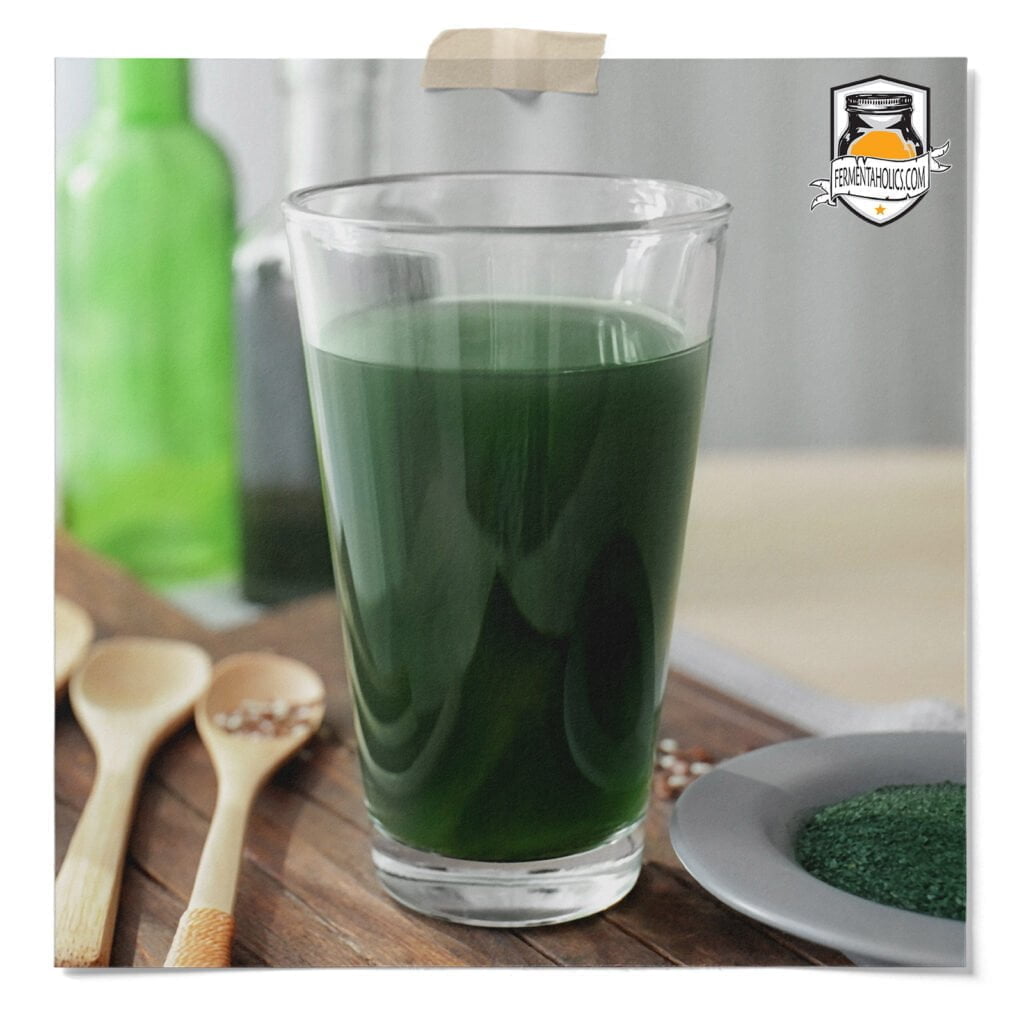
Looking for a good way to start your day? How about a healthy glass of golden raisin spirulina kombucha. What is spirulina? Spirulina is dried blue-green algae that are readily available in powdered form in health food stores. Its dense nutritional content and provided health benefits land it at the top of the superfood charts. Spirulina is protein-rich and aids in detoxification, immune health, and increased energy. Also, it will make your kombucha come out a beautiful deep green.
This is a perfect recipe to make for St Patricks Day. Maybe this year, instead of just tossing green food coloring in your beer, you’ll add spirulina instead. At least this way, you’ll get some health benefits, and your body will thank you! After a fun-filled day of drinking or eating junk, ahem, St. Paddy’s Day, your body could use all the help it can get in detoxifying and increasing energy. We also added golden raisins to represent little golden nuggets, and we’ll call it Leprechaun-Bucha.


It’s important to note that making homemade kombucha is almost always a two-step fermentation process. Brewing kombucha is only a one-step process for those who prefer an unflavored flat kombucha. Otherwise, the steps consist of a primary fermentation and secondary fermentation.
Primary fermentation is the first step of the kombucha brewing process. This is where your SCOBY transforms regular sweet tea into the tart and slightly sweet kombucha we love. At the end of this stage, you will have finished kombucha, but it will be flat and unflavored. Have you skipped this step? Then check out our guide on how to make kombucha at home, and for jun kombucha, see our post on how to make jun kombucha tea at home. Traditional kombucha is going to yield a bolder brew, while jun kombucha is milder and can be a bit tarter.
Secondary fermentation is the step where you bottle, carbonate, and flavor your kombucha with the addition of sugar and flavors. In this step, the finished kombucha from the primary is mixed with sugar, fruits, or other flavors before bottling it with specialized lids that can hold pressure, like flip-top bottles. The bottled kombucha is then left at room temperature for natural fermentation, where yeast carbonates the kombucha within the sealed bottle. The ideal temperature range for this process is between 75-85°F. The amount of time needed to carbonate within the bottle is highly tied to temperature, which can take anywhere from 2-10 days.
💡Since this recipe is for the secondary fermentation, to make this recipe, you’ll need to have kombucha that has finished the primary fermentation and is ready to bottle.
17 fl oz
Bottles10
minutes1-3
DaysThis Golden Raisin Spirulina Kombucha Recipe is for a one-gallon batch. Before bottling your kombucha, remove the SCOBY pellicle along with 12-16 ounces of kombucha starter tea from your brew, and reserve it for your next batch
112 Oz Kombucha From Primary Fermentation. 112 oz = one-gallon kombucha minus 16 oz for a future batch. * See #1 notes below.
6 TBSP Golden Raisins
2 TBSP Spirulina Powder
7 16 Oz Airtight Bottles
Measuring Spoons
Blender
Using a funnel, add spirulina powder evenly to each bottle.
Now evenly distribute the golden raisins.
Fill each bottle with kombucha, leaving about 1 to 2 inches of headspace. Tightly place the caps on each bottle. * See #2 & #3 notes below.
Keep bottles at room temperature for 2-10 days; it will carbonate faster at higher temperatures and slower when cold.
Once per day, you’ll want to burp the bottles. This is done by removing the cap to allow built-up pressure to escape then placing the cap back on. As soon as you put the lid back on, the carbonation will begin to build back up, so no worries about it getting flat. Try not to skip this, or you may get kombucha all over your face when you do go to open it or, worse yet, a bottle bomb. * See #4 notes below.
Chill in the refrigerator once you’re happy with the carbonation levels. Based on preference, you can serve as is or strain before drinking.
